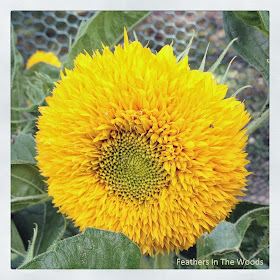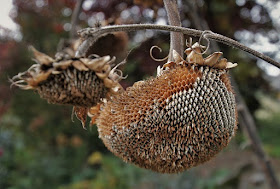In fact they are one of the easiest to grow food crops. You can easily harvest the seeds for yourself, to share with your chickens or even the wild birds.
There are several types of sunflowers you can grow for seed or flowers. I've grown everything from the black oil sunflower seeds that you commonly buy for bird seed and the common mammoth sunflower, to ornamental Teddy Bear sunflowers and a pretty Tigers Eye variety.
The larger sunflowers obviously produce more sunflower seeds. They also produce larger seeds. Each sunflower head produces between 1000-2000 seeds!
Smaller ornamental varieties don't produce as many seeds but the seeds they do produce are still edible. Many of the sunflower varieties have been developed more for the flower than the seeds, so you might have to try a few varieties and see what produces the most seed for the type you want to grow. Unless you're only in it for the flowers...then absolutely choose by color, flower size etc.
Ornamental varieties are often small enough to fit into flower gardens or even containers. Which is great because no matter what the size of the garden spot you have you can find a sunflower to fit!
How to grow sunflowers
Sunflowers are easy to grow and really need nothing more than a sunny spot and lots of water. Depending on your growing season you might want to start seeds indoors. I'm in zone 5B and like to start my seeds indoors about a month before my projected last frost date. (here's how to find the last frost date for your zone).
If you want to direct sow, wait till your soil reaches at least 55°F, preferably warmer.
Check your seed packet for exact sowing information. If no information (like if you want to plant some bird seed sunflowers) sow seeds about 1" deep in soil amended with compost. Keep soil moist during germination.
Sunflowers prefer a well draining soil and 6-8 hours of sun. Seeds germinate well indoors at room temperature, so a heat mat is not necessary.
I like to plant sunflowers in the vegetable garden since they help with aphids by drawing them away from other more delicate plants.
Different varieties of sunflowers will have different spacing requirements. In general the larger the sunflower the further apart they need to be. Mammoth sunflowers should be about 2 feet apart and dwarf varieties as close as 6" apart. It helps to picture how large the plant will be, then space them so the leaves will barely touch when full grown.
Mulch well to help keep moisture in the soil. If you sow early, then you may have to cover the seedlings if a sudden frost pops up. A quick tunnel made from a sheet of clear plastic and something to keep it from resting on the seedlings should suffice.
Sunflowers need a bit more water than most flowers do. Make sure to water your sunflowers at least once a week. Water more often if the soil dries out completely. Water well enough so that the soil is wet about a foot down.
As sunflowers grow their flower buds turn to face the sun as it moves through the sky. This is called heliotropism. Once the flower is mature it will settle into a fixed position. The plant stalks are green up till now but as the flower starts to work on seed production the stalks will yellow.
Some of the largest varieties might need staked once they grow to their full height. I like to plant them next to the garden fence then use soft rope or strips of old t-shirt material or pantyhose to tie them up if they start to fall over. If they hang too far over, the squirrels (and chickens if you have them) will help themselves to the seeds they can reach!
Harvesting sunflower seeds
After the sunflower matures, the head will start to droop and dry out. The stalks will turn brown when the flower heads are ready to harvest. You'll now be in a race with the wild birds to see who can get to the seeds first. To prevent birds from eating all the seeds, you can tie a mesh bag around the flower.
I usually just cut the flower heads off after the petals have dried up and fallen off. I put the flower heads in a warm, dry place to dry out. The drier the seed heads are the easier it is to remove the seeds.
If you are growing sunflowers simply for the pretty flowers, then allow the birds and wildlife to come eat the seeds. If squirrels, chipmunks and such are causing other damage in your garden you'll want to remove the flower heads and set them outside the garden for the critters.
If you allow the flowers to dry out while still on the stalk, prepare to find sunflowers sprouting up in that area next year! Dropped seeds will grow.
To remove the seeds, wait until they are dry enough that they pop out with very little pressure. Simply rub your fingers against the seeds and they will pop out. Do this above a bucket or a large sheet to collect the seeds as they fall.
Watch an utterly hypnotizing Instagram video of Laura from You Should Grow de-seeding a dried sunflower seed head.
To store seeds long term you'll want them to be completely dry to prevent mold, so allow them to sit out in a dry room for a few days or pop into the dehydrator on low for a short while. Once seeds are completely dry, save them in a cool dry place. I use mason jars.
Admittedly, I never try to save seeds from certain varieties like the Teddy Bear sunflowers. Can you blame me? I can't even find the seeds under all that flower! lol
Many seeds are available widely and rather inexpensively now. Although I ordered my first set of seeds, I now see them at the Dollar tree when I go shopping for cheap garden supplies each spring.
Sunflowers are an easy to grow, eye catching annual that you can grow in just about any yard or garden. What kind of sunflowers will you grow next year?
Want to learn more about growing your own flowers? Check out my top posts on flower gardening and learn to grow Rhododendrons, Lavender, 4 O' clocks and more!
~L
Want gardening and healthy living information sent right to your email weekly? Click right here to join my newsletter list and get new posts sent directly to you the day they're published!






No comments:
Post a Comment